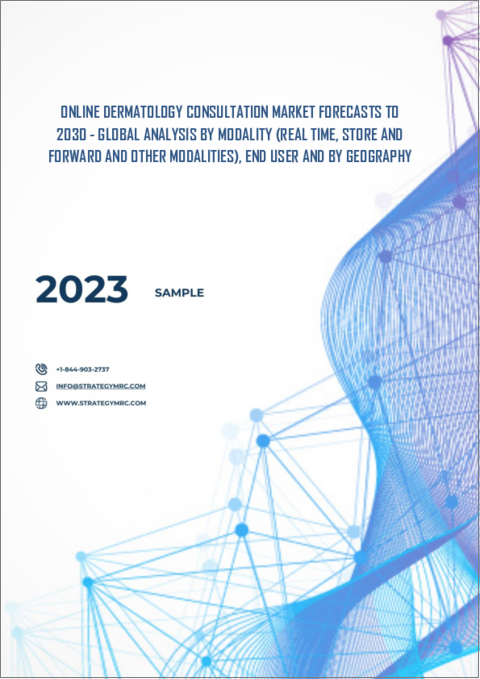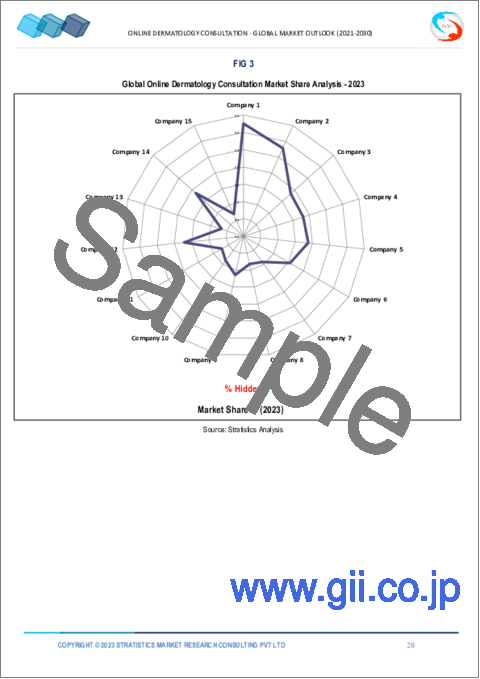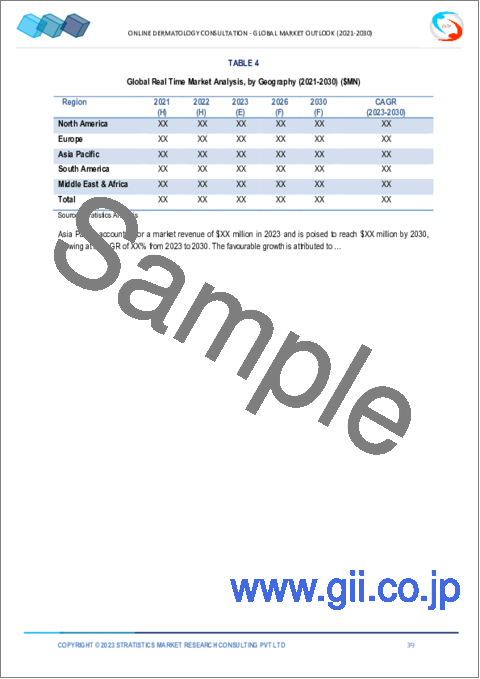|
|
市場調査レポート
商品コード
1324323
オンライン皮膚科診察市場の2030年までの予測:モダリティ別、エンドユーザー別、地域別の世界分析Online Dermatology Consultation Market Forecasts to 2030 - Global Analysis By Modality (Real Time, Store and Forward and Other Modalities), End User and By Geography |
||||||
カスタマイズ可能
|
|||||||
| オンライン皮膚科診察市場の2030年までの予測:モダリティ別、エンドユーザー別、地域別の世界分析 |
|
出版日: 2023年08月01日
発行: Stratistics Market Research Consulting
ページ情報: 英文 175+ Pages
納期: 2~3営業日
|
- 全表示
- 概要
- 図表
- 目次
Stratistics MRCによると、世界のオンライン皮膚科診察市場は2023年に33億3,000万米ドルを占め、予測期間中のCAGRは16.9%で成長し、2030年には99億4,000万米ドルに達する見込みです。
オンライン皮膚科診察には、ビデオ診察やスマートフォンアプリなど、さまざまな技術が関わっています。ストア・アンド・フォワード方式は、皮膚科を含む様々な下位専門分野での遠隔診察に使用できる様々な方式の1つです。現代のヘルスケアサービスと患者の医療へのアクセスを向上させる重要なツールは、遠隔医療分野における最近の進歩から大きな恩恵を受けています。
2020年12月にJAAD International誌に掲載された調査論文によると、診療に遠隔医療を導入している皮膚科医の割合は、2016年の15.0%からパンデミックのピーク時には約50.0%に増加しました。
皮膚科疾患の有病率の増加
湿疹、乾癬、皮膚がんなどの慢性皮膚疾患の有病率の劇的な上昇が、皮膚科治療に対する需要が急増している原因です。オンライン診察は交通費を節約でき、ヘルスケア全体のコストを下げることができるため、従来の対面式診察よりも手頃な価格で受けることができます。また、特定の皮膚疾患にかかりやすい高齢化社会と食生活の変化も、予測期間中の世界市場の成長を促進すると予測されています。
医師の遠隔医療利用頻度が低い
流行の初期段階では、医師、特に皮膚科医はオンライン診察の利用を大幅に増やしました。さらに、ヘルスケア施設は、オンライン皮膚科診察システムの高額な初期費用と継続的なメンテナンスの両方に責任を負う。最新の通信機器の不足により、皮膚科診察中の映像や音声が不十分であるという技術的な懸念は、市場の成長を妨げる要因のひとつです。
皮膚科医不足の深刻化
人口100万人当たりの皮膚科医数の減少は、オンライン皮膚科診察市場の成長に影響を与える主な要因の一つです。一部の先進国でも、皮膚科医の不足が患者の待ち時間の長さや反応の遅れを招いています。このため、患者も皮膚科医も、予測期間中に皮膚科治療を受けるために遠隔医療を利用し始めると思われます。
認識不足
地方の人々は、こうしたサービスを受けるために必要な専門知識や資源が不足しており、これがオンライン診察の世界市場拡大の大きな障害となっています。さらに、医師と患者が直接対話することをいまだに信じている患者もいます。もう一つの問題は、インフラを整えるための高額な費用です。したがって、これらは市場の成長を妨げる問題です。
COVID-19の影響:
COVID-19の流行に市場は好意的に反応しました。好ましい法規制、オンライン皮膚科受診の増加、対面診療の減少により、市場は著しく高い成長率を示しました。コロナウイルスの蔓延を食い止めるため、政府当局はロックダウンや物理的接触の制限など多くの対策を実施し、ヘルスケア関係者との直接面会が激減しました。さらに、この病気の蔓延を食い止めるための多くの組織による取り組みが、予測期間中の市場拡大を後押ししました。
予測期間中、ストア&フォワード・セグメントが最大になる見込み
ストア&フォワード・セグメントは有利な成長を遂げると推定されます。オンライン皮膚科診察のモダリティとしてバーチャル診察が広く利用されているため、ストア&フォワード部門が市場の大部分を占めています。障害の正確な評価のための皮膚科画像に対する需要の増加により、このビジネスは店舗と前方様式に大きく依存しています。皮膚科医不足を補うためにこの技術が積極的に利用されることで、世界の市場シェアが高まる可能性があります。
予測期間中にCAGRが最も高くなると予想される在宅ケア分野
ホームケア分野は、業界参加者によるイニシアチブの利用拡大により、予測期間中に最も速いCAGRの成長が見込まれます。この分野は、自宅にいながらオンラインで皮膚科の診察を受けようとする患者の増加により、世界市場で最も高い収益を上げると予測されます。高齢者の遠隔診察の利用が増加していることや、在宅医療の現場で遠隔から適切なモニタリングができるようになったことも、病院を受診する必要性が少なくなり、この分野の成長に寄与している要因のひとつです。
最大のシェアを占める地域:
北米は、複数のヘルスケア施設によるオンラインプラットフォームの迅速な導入と利用により、予測期間中最大の市場シェアを占めると予測されます。同市場はまた、強力な米国政府と重要企業の増加によっても牽引されると予想されます。高成長国は、新しい技術の利用が増加し、遠隔皮膚科サービスが向上しているため、市場成長に貢献すると思われ、この分野での市場成長速度の加速につながると予測されます。
CAGRが最も高い地域:
アジア太平洋地域は、遠隔医療サービスを支持する政府政策の存在や、主要国におけるオンライン皮膚科診察の需要の高まりなどの要因により、予測期間中に最も高いCAGRを示すと予測されます。発展途上国では遠隔皮膚科機器の利用が制限されており、償還の見通しもあまり芳しくないため、予測期間の成長率は大幅に鈍化するとみられます。
無料カスタマイズサービス:
本レポートをご購読のお客様には、以下のいずれかの無料カスタマイズオプションをご提供いたします:
- 企業プロファイル
- 追加市場プレイヤーの包括的プロファイリング(3社まで)
- 主要企業のSWOT分析(3社まで)
- 地域セグメンテーション
- 顧客の関心に応じた主要国の市場推計・予測・CAGR(注:フィージビリティチェックによる)
- 競合ベンチマーキング
- 製品ポートフォリオ、地理的プレゼンス、戦略的提携に基づく主要企業のベンチマーキング
目次
第1章 エグゼクティブサマリー
第2章 序文
- 概要
- ステークホルダー
- 調査範囲
- 調査手法
- データマイニング
- データ分析
- データ検証
- 調査アプローチ
- 調査ソース
- 1次調査ソース
- 2次調査ソース
- 仮定
第3章 市場動向分析
- 促進要因
- 抑制要因
- 機会
- 脅威
- エンドユーザー分析
- 新興市場
- 新型コロナウイルス感染症(COVID-19)の影響
第4章 ポーターのファイブフォース分析
- 供給企業の交渉力
- 買い手の交渉力
- 代替品の脅威
- 新規参入業者の脅威
- 競争企業間の敵対関係
第5章 世界のオンライン皮膚科診察市場:モダリティ別
- リアルタイム
- ストアアンドフォワード
- その他のモダリティ
第6章 世界のオンライン皮膚科診察市場:エンドユーザー別
- ホームケア
- ヘルスケアユニット
- その他のエンドユーザー
第7章 世界のオンライン皮膚科診察市場:地域別
- 北米
- 米国
- カナダ
- メキシコ
- 欧州
- ドイツ
- 英国
- イタリア
- フランス
- スペイン
- その他欧州
- アジア太平洋地域
- 日本
- 中国
- インド
- オーストラリア
- ニュージーランド
- 韓国
- その他アジア太平洋地域
- 南米
- アルゼンチン
- ブラジル
- チリ
- その他南米
- 中東とアフリカ
- サウジアラビア
- アラブ首長国連邦
- カタール
- 南アフリカ
- その他中東とアフリカ
第8章 主な発展
- 契約、パートナーシップ、コラボレーション、合弁事業
- 買収と合併
- 新製品の発売
- 事業拡大
- その他の主要戦略
第9章 会社概要
- Apollo TeleHealth
- Amwell
- Teladoc Health, Inc.
- DermatoVirtual
- Doctor On Demand, Inc.
- Lybrate, Inc.
- HealthHero
- DermatologistOnCall
- Conexa
- Beijing Jingdong Technology Co., Ltd.
- First Derm
- GE Healthcare
- CureSkin
- Aerotel Medical Systems Ltd.
- Honeywell Life Care Solutions
- Allscripts Healthcare, LLC
- 3Derm
- Philips Healthcare
- MetaOptima
- McKesson Corporation
List of Tables
- Table 1 Global Online Dermatology Consultation Market Outlook, By Region (2021-2030) ($MN)
- Table 2 Global Online Dermatology Consultation Market Outlook, By Modality (2021-2030) ($MN)
- Table 3 Global Online Dermatology Consultation Market Outlook, By Real Time (2021-2030) ($MN)
- Table 4 Global Online Dermatology Consultation Market Outlook, By Store and Forward (2021-2030) ($MN)
- Table 5 Global Online Dermatology Consultation Market Outlook, By Other Modalities (2021-2030) ($MN)
- Table 6 Global Online Dermatology Consultation Market Outlook, By End User (2021-2030) ($MN)
- Table 7 Global Online Dermatology Consultation Market Outlook, By Homecare (2021-2030) ($MN)
- Table 8 Global Online Dermatology Consultation Market Outlook, By Healthcare units (2021-2030) ($MN)
- Table 9 Global Online Dermatology Consultation Market Outlook, By Other End Users (2021-2030) ($MN)
- Table 10 North America Online Dermatology Consultation Market Outlook, By Country (2021-2030) ($MN)
- Table 11 North America Online Dermatology Consultation Market Outlook, By Modality (2021-2030) ($MN)
- Table 12 North America Online Dermatology Consultation Market Outlook, By Real Time (2021-2030) ($MN)
- Table 13 North America Online Dermatology Consultation Market Outlook, By Store and Forward (2021-2030) ($MN)
- Table 14 North America Online Dermatology Consultation Market Outlook, By Other Modalities (2021-2030) ($MN)
- Table 15 North America Online Dermatology Consultation Market Outlook, By End User (2021-2030) ($MN)
- Table 16 North America Online Dermatology Consultation Market Outlook, By Homecare (2021-2030) ($MN)
- Table 17 North America Online Dermatology Consultation Market Outlook, By Healthcare units (2021-2030) ($MN)
- Table 18 North America Online Dermatology Consultation Market Outlook, By Other End Users (2021-2030) ($MN)
- Table 19 Europe Online Dermatology Consultation Market Outlook, By Country (2021-2030) ($MN)
- Table 20 Europe Online Dermatology Consultation Market Outlook, By Modality (2021-2030) ($MN)
- Table 21 Europe Online Dermatology Consultation Market Outlook, By Real Time (2021-2030) ($MN)
- Table 22 Europe Online Dermatology Consultation Market Outlook, By Store and Forward (2021-2030) ($MN)
- Table 23 Europe Online Dermatology Consultation Market Outlook, By Other Modalities (2021-2030) ($MN)
- Table 24 Europe Online Dermatology Consultation Market Outlook, By End User (2021-2030) ($MN)
- Table 25 Europe Online Dermatology Consultation Market Outlook, By Homecare (2021-2030) ($MN)
- Table 26 Europe Online Dermatology Consultation Market Outlook, By Healthcare units (2021-2030) ($MN)
- Table 27 Europe Online Dermatology Consultation Market Outlook, By Other End Users (2021-2030) ($MN)
- Table 28 Asia Pacific Online Dermatology Consultation Market Outlook, By Country (2021-2030) ($MN)
- Table 29 Asia Pacific Online Dermatology Consultation Market Outlook, By Modality (2021-2030) ($MN)
- Table 30 Asia Pacific Online Dermatology Consultation Market Outlook, By Real Time (2021-2030) ($MN)
- Table 31 Asia Pacific Online Dermatology Consultation Market Outlook, By Store and Forward (2021-2030) ($MN)
- Table 32 Asia Pacific Online Dermatology Consultation Market Outlook, By Other Modalities (2021-2030) ($MN)
- Table 33 Asia Pacific Online Dermatology Consultation Market Outlook, By End User (2021-2030) ($MN)
- Table 34 Asia Pacific Online Dermatology Consultation Market Outlook, By Homecare (2021-2030) ($MN)
- Table 35 Asia Pacific Online Dermatology Consultation Market Outlook, By Healthcare units (2021-2030) ($MN)
- Table 36 Asia Pacific Online Dermatology Consultation Market Outlook, By Other End Users (2021-2030) ($MN)
- Table 37 South America Online Dermatology Consultation Market Outlook, By Country (2021-2030) ($MN)
- Table 38 South America Online Dermatology Consultation Market Outlook, By Modality (2021-2030) ($MN)
- Table 39 South America Online Dermatology Consultation Market Outlook, By Real Time (2021-2030) ($MN)
- Table 40 South America Online Dermatology Consultation Market Outlook, By Store and Forward (2021-2030) ($MN)
- Table 41 South America Online Dermatology Consultation Market Outlook, By Other Modalities (2021-2030) ($MN)
- Table 42 South America Online Dermatology Consultation Market Outlook, By End User (2021-2030) ($MN)
- Table 43 South America Online Dermatology Consultation Market Outlook, By Homecare (2021-2030) ($MN)
- Table 44 South America Online Dermatology Consultation Market Outlook, By Healthcare units (2021-2030) ($MN)
- Table 45 South America Online Dermatology Consultation Market Outlook, By Other End Users (2021-2030) ($MN)
- Table 46 Middle East & Africa Online Dermatology Consultation Market Outlook, By Country (2021-2030) ($MN)
- Table 47 Middle East & Africa Online Dermatology Consultation Market Outlook, By Modality (2021-2030) ($MN)
- Table 48 Middle East & Africa Online Dermatology Consultation Market Outlook, By Real Time (2021-2030) ($MN)
- Table 49 Middle East & Africa Online Dermatology Consultation Market Outlook, By Store and Forward (2021-2030) ($MN)
- Table 50 Middle East & Africa Online Dermatology Consultation Market Outlook, By Other Modalities (2021-2030) ($MN)
- Table 51 Middle East & Africa Online Dermatology Consultation Market Outlook, By End User (2021-2030) ($MN)
- Table 52 Middle East & Africa Online Dermatology Consultation Market Outlook, By Homecare (2021-2030) ($MN)
- Table 53 Middle East & Africa Online Dermatology Consultation Market Outlook, By Healthcare units (2021-2030) ($MN)
- Table 54 Middle East & Africa Online Dermatology Consultation Market Outlook, By Other End Users (2021-2030) ($MN)
According to Stratistics MRC, the Global Online Dermatology Consultation Market is accounted for $3.33 billion in 2023 and is expected to reach $9.94 billion by 2030 growing at a CAGR of 16.9% during the forecast period. Online dermatology consultations involve a range of technology, including as video consultations and smartphone apps. The store-and-forward modality is one of the various modalities that can be used for teleconsultation in a range of subspecialties, including dermatology. Modern healthcare services and a crucial tool for increasing patients' access to medical care have benefited greatly from recent advancements in the field of telemedicine.
According to a research paper published in the journal JAAD International in December 2020, the proportion of dermatologists who implemented telehealth in their practice increased from 15.0% in 2016 to around 50.0% during the peak level of the pandemic.
Market Dynamics:
Driver:
Increased prevalence of dermatological disorders
The dramatic rise in the prevalence of chronic skin disorders like eczema, psoriasis, and skin cancer is the cause of the sudden growth in demand for dermatological treatments. As they avoid travel costs and lower overall healthcare costs, online consultations can be more affordable than conventional in-person sessions. The ageing population, which is more prone to certain skin conditions and dietary changes are also projected to fuel the growth of the global market over the forecast period.
Restraint:
Physicians are using telemedicine less frequently
During the early phases of the epidemic, physicians, particularly dermatologists, drastically boosted their usage of online consultations. Additionally, healthcare facilities are liable for both the high initial cost and continuous maintenance of online dermatological consultation systems. Technology concerns connected to poor video or audio during dermatology consultations due to a lack of the most recent telecommunication devices are one of the factors that are expected to hinder the growth of the market.
Opportunity:
Rising shortage of dermatologists
The decline in the number of dermatologists per million people is one of the major factors influencing the growth of the online dermatology consultation market. Even in some industrialised nations, the lack of dermatologists causes lengthy wait times for patients and a slow reaction time. Due to this, patients and dermatologists will both start using telemedicine to get dermatological care during the projection period.
Threat:
Lack of awareness
Rural people lack the expertise and resources necessary to get these services, which is a significant obstacle to the expansion of the worldwide market for online doctor consultations. Additionally, some patients still believe in direct doctor-patient interactions. Another problem is the expensive expense of setting up the infrastructure. Therefore, these are the issues impeding the market's growth.
COVID-19 Impact:
The market responded favourably to the COVID-19 epidemic. Due to favourable legislation, rising online dermatology consultations, and a drop in in-person doctor visits, the market saw a remarkably high growth rate. To stop the spread of the coronavirus, government officials implemented a number of measures, such as lockdowns and limitations on physical contact, which sharply decreased the number of in-person encounters with healthcare personnel. Additionally, initiatives by a number of organisations to stop the spread of the disease aided market expansion during the projection period.
The store and forward segment is expected to be the largest during the forecast period
The store and forward segment is estimated to have a lucrative growth. The store and forward sectors held the lion's share of the market because to the extensive usage of virtual consultations as a modality for online dermatological consultations. The business is heavily reliant on the store and forward modality due to the increasing demand for dermatological images for the accurate evaluation of disorders. The aggressive usage of this technique to make up for the dermatologist shortage could boost the market share globally.
The homecare segment is expected to have the highest CAGR during the forecast period
The homecare segment is anticipated to witness the fastest CAGR growth during the forecast period, owing to the expanded availability of initiatives by industry participants. The sector is predicted to generate the highest revenues in the global market due to an increase in patients seeking online dermatological consultations from the convenience of their homes. The older population's increased usage of teleconsultation and the ability to properly monitor them remotely in home care settings are some other factors contributing to the segment's growth because they lessen the necessity for hospital visits.
Region with Largest share:
North America is projected to hold the largest market share during the forecast period owing to the quick adoption and use of online platforms by several healthcare facilities. The market is also expected to be driven by a strong U.S. government and an increase in important companies. High-growing nations would contribute to the market growth due to the rising usage of newer technology and improved tele dermatological services, which is projected to lead to a faster rate of market growth in the area.
Region with highest CAGR:
Asia Pacific is projected to have the highest CAGR over the forecast period, owing to increase as a result of factors including the existence of a supportive government policy for telemedicine services and the rising demand for online dermatology consultation in important nations. Due to the restricted availability of tele dermatology equipment in developing nations and the less favorable reimbursement prospects would increase at a significantly slower rate.
Key players in the market:
Some of the key players profiled in the Online Dermatology Consultation Market include: Apollo TeleHealth, Amwell, Teladoc Health, Inc., DermatoVirtual, Doctor On Demand, Inc., Lybrate, Inc., HealthHero, DermatologistOnCall, Conexa, Beijing Jingdong Technology Co., Ltd., Doctolib, GE Healthcare, CureSkin, Aerotel Medical Systems Ltd., Honeywell Life Care Solutions, Allscripts Healthcare, LLC, 3Derm, Philips Healthcare, MetaOptima and McKesson Corporation.
Key Developments:
In February 2022, Teladoc Health Inc. launched Chronic Care Complete, a chronic condition management solution that helps individuals living with multiple chronic conditions to improve their health outcomes.
In March 2021, Doctolib introduced a new generation of medical software called Doctolib medecin. This software combines features like intelligent document management, invoicing, and teletransmission on mobile devices with the sharing of online prescriptions to cut down on the time doctors spend on administration and help improve the care of their patients.
Modalities Covered:
- Real Time
- Store and Forward
- Other Modalities
End Users Covered:
- Homecare
- Healthcare units
- Other End Users
Regions Covered:
- North America
- US
- Canada
- Mexico
- Europe
- Germany
- UK
- Italy
- France
- Spain
- Rest of Europe
- Asia Pacific
- Japan
- China
- India
- Australia
- New Zealand
- South Korea
- Rest of Asia Pacific
- South America
- Argentina
- Brazil
- Chile
- Rest of South America
- Middle East & Africa
- Saudi Arabia
- UAE
- Qatar
- South Africa
- Rest of Middle East & Africa
What our report offers:
- Market share assessments for the regional and country-level segments
- Strategic recommendations for the new entrants
- Covers Market data for the years 2021, 2022, 2023, 2026, and 2030
- Market Trends (Drivers, Constraints, Opportunities, Threats, Challenges, Investment Opportunities, and recommendations)
- Strategic recommendations in key business segments based on the market estimations
- Competitive landscaping mapping the key common trends
- Company profiling with detailed strategies, financials, and recent developments
- Supply chain trends mapping the latest technological advancements
Free Customization Offerings:
All the customers of this report will be entitled to receive one of the following free customization options:
- Company Profiling
- Comprehensive profiling of additional market players (up to 3)
- SWOT Analysis of key players (up to 3)
- Regional Segmentation
- Market estimations, Forecasts and CAGR of any prominent country as per the client's interest (Note: Depends on feasibility check)
- Competitive Benchmarking
- Benchmarking of key players based on product portfolio, geographical presence, and strategic alliances
Table of Contents
1 Executive Summary
2 Preface
- 2.1 Abstract
- 2.2 Stake Holders
- 2.3 Research Scope
- 2.4 Research Methodology
- 2.4.1 Data Mining
- 2.4.2 Data Analysis
- 2.4.3 Data Validation
- 2.4.4 Research Approach
- 2.5 Research Sources
- 2.5.1 Primary Research Sources
- 2.5.2 Secondary Research Sources
- 2.5.3 Assumptions
3 Market Trend Analysis
- 3.1 Introduction
- 3.2 Drivers
- 3.3 Restraints
- 3.4 Opportunities
- 3.5 Threats
- 3.6 End User Analysis
- 3.7 Emerging Markets
- 3.8 Impact of Covid-19
4 Porters Five Force Analysis
- 4.1 Bargaining power of suppliers
- 4.2 Bargaining power of buyers
- 4.3 Threat of substitutes
- 4.4 Threat of new entrants
- 4.5 Competitive rivalry
5 Global Online Dermatology Consultation Market, By Modality
- 5.1 Introduction
- 5.2 Real Time
- 5.3 Store and Forward
- 5.4 Other Modalities
6 Global Online Dermatology Consultation Market, By End User
- 6.1 Introduction
- 6.2 Homecare
- 6.3 Healthcare units
- 6.4 Other End Users
7 Global Online Dermatology Consultation Market, By Geography
- 7.1 Introduction
- 7.2 North America
- 7.2.1 US
- 7.2.2 Canada
- 7.2.3 Mexico
- 7.3 Europe
- 7.3.1 Germany
- 7.3.2 UK
- 7.3.3 Italy
- 7.3.4 France
- 7.3.5 Spain
- 7.3.6 Rest of Europe
- 7.4 Asia Pacific
- 7.4.1 Japan
- 7.4.2 China
- 7.4.3 India
- 7.4.4 Australia
- 7.4.5 New Zealand
- 7.4.6 South Korea
- 7.4.7 Rest of Asia Pacific
- 7.5 South America
- 7.5.1 Argentina
- 7.5.2 Brazil
- 7.5.3 Chile
- 7.5.4 Rest of South America
- 7.6 Middle East & Africa
- 7.6.1 Saudi Arabia
- 7.6.2 UAE
- 7.6.3 Qatar
- 7.6.4 South Africa
- 7.6.5 Rest of Middle East & Africa
8 Key Developments
- 8.1 Agreements, Partnerships, Collaborations and Joint Ventures
- 8.2 Acquisitions & Mergers
- 8.3 New Product Launch
- 8.4 Expansions
- 8.5 Other Key Strategies
9 Company Profiling
- 9.1 Apollo TeleHealth
- 9.2 Amwell
- 9.3 Teladoc Health, Inc.
- 9.4 DermatoVirtual
- 9.5 Doctor On Demand, Inc.
- 9.6 Lybrate, Inc.
- 9.7 HealthHero
- 9.8 DermatologistOnCall
- 9.9 Conexa
- 9.10 Beijing Jingdong Technology Co., Ltd.
- 9.11 First Derm
- 9.12 GE Healthcare
- 9.13 CureSkin
- 9.14 Aerotel Medical Systems Ltd.
- 9.15 Honeywell Life Care Solutions
- 9.16 Allscripts Healthcare, LLC
- 9.17 3Derm
- 9.18 Philips Healthcare
- 9.19 MetaOptima
- 9.20 McKesson Corporation






